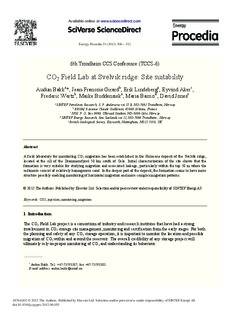| dc.contributor.author | Bakk, Audun | |
| dc.contributor.author | Girard, Jean-Francois | |
| dc.contributor.author | Lindeberg, Erik Gøsta Brun | |
| dc.contributor.author | Aker, Eyvind | |
| dc.contributor.author | Wertz, Frederic | |
| dc.contributor.author | Buddensiek, Maike-Liselotte | |
| dc.contributor.author | Barrio, Maria | |
| dc.contributor.author | Jones, David | |
| dc.date.accessioned | 2016-11-03T06:45:21Z | |
| dc.date.accessioned | 2016-12-13T09:46:58Z | |
| dc.date.available | 2016-11-03T06:45:21Z | |
| dc.date.available | 2016-12-13T09:46:58Z | |
| dc.date.issued | 2012 | |
| dc.identifier.citation | Energy Procedia 2012, 23:306-312 | |
| dc.identifier.issn | 1876-6102 | |
| dc.identifier.uri | http://hdl.handle.net/11250/2425000 | |
| dc.description | - | |
| dc.description.abstract | A field laboratory for monitoring CO2 migration has been established in the Holocene deposit of the Svelvik ridge, located at the sill of the Drammensfjord 50 km south of Oslo. Initial characterization of the site shows that the formation is very suitable for studying migration and associated leakage, particularly within the top 50 m where the sediments consist of relatively homogenous sand. In the deeper part of the deposit, the formation seems to have more structure possibly enabling monitoring of horizontal migration and more complex migration patterns. Copyright © 2012 Published by Elsevier Ltd. | |
| dc.language.iso | eng | |
| dc.title | CO2 Field Lab at Svelvik Ridge: Site Suitability | |
| dc.type | Journal article | |
| dc.date.updated | 2016-11-03T06:45:20Z | |
| dc.identifier.doi | 10.1016/j.egypro.2012.06.055 | |
| dc.identifier.cristin | 943017 | |
